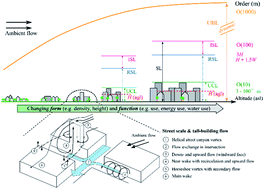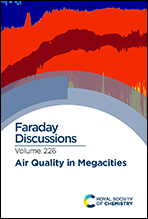Variability of physical meteorology in urban areas at different scales: implications for air quality
Abstract
Air quality in cities is influenced not only by emissions and chemical transformations but also by the physical state of the atmosphere which varies both temporally and spatially. Increasingly, tall buildings (TB) are common features of the urban landscape, yet their impact on urban air flow and dispersion is not well understood, and their effects are not appropriately captured in parameterisation schemes. Here, hardware models of areas within two global mega-cities (London and Beijing) are used to analyse the impact of TB on flow and transport in isolated and cluster settings. Results show that TB generate strong updrafts and downdrafts that affect street-level flow fields. Velocity differences do not decay monotonically with distance from the TB, especially in the near-wake region where the flow is characterised by recirculating winds and jets. Lateral distance from an isolated TB centreline is crucial, and flow is still strongly impacted at longitudinal distances of several TB heights. Evaluation of a wake-flow scheme (ADMS–Build) in the isolated TB case indicates important characteristics are not captured. There is better agreement for a slender, shorter TB than a taller non-cuboidal TB. Better prediction of flow occurs horizontally further away and vertically further from the surface. TB clusters modify the shape of pollutant plumes. Strong updrafts generated by the overlapping wakes of TB clusters lift pollutants out of the canopy, causing a much deeper tracer plume in the lee of the cluster, and an elevated plume centreline with maximum concentrations around the TB mean height. Enhanced vertical spread of the pollutants in the near-wake of the cluster results in overall lower maximum concentrations, but higher concentrations above the mean TB height. These results have important implications for interpreting observations in areas with TB. Using real world ceilometer observations in two mega-cities (Beijing and Paris), we assess the diurnal seasonal variability of the urban boundary layer and evaluate a mixed layer height (MLH) empirical model with parameters derived from a third mega-city (London). The MLH model works well in central Beijing but less well in suburban Paris. The variability of the physical meteorology across different vertical scales discussed in this paper provides additional context for interpreting air quality observations.

- This article is part of the themed collection: Air quality in megacities


 Please wait while we load your content...
Please wait while we load your content...